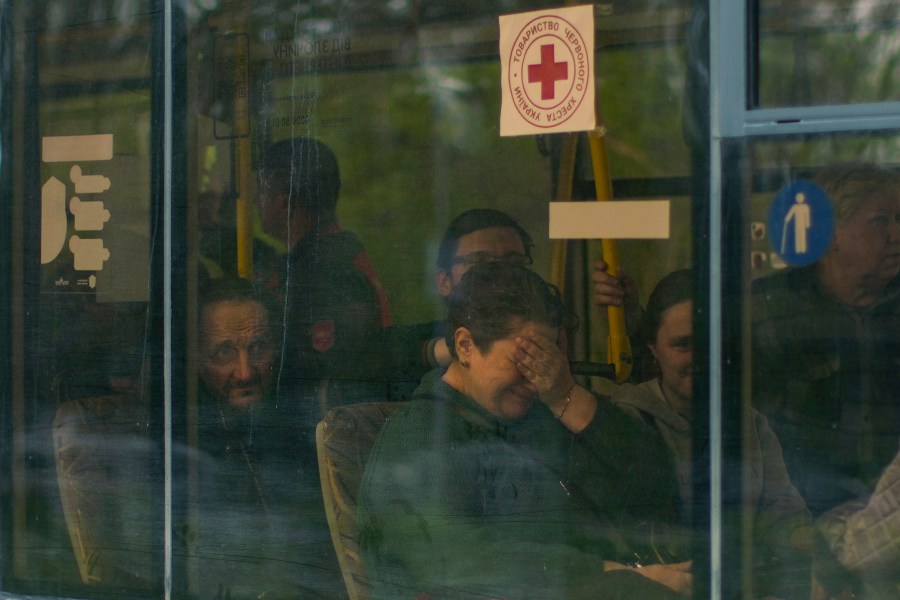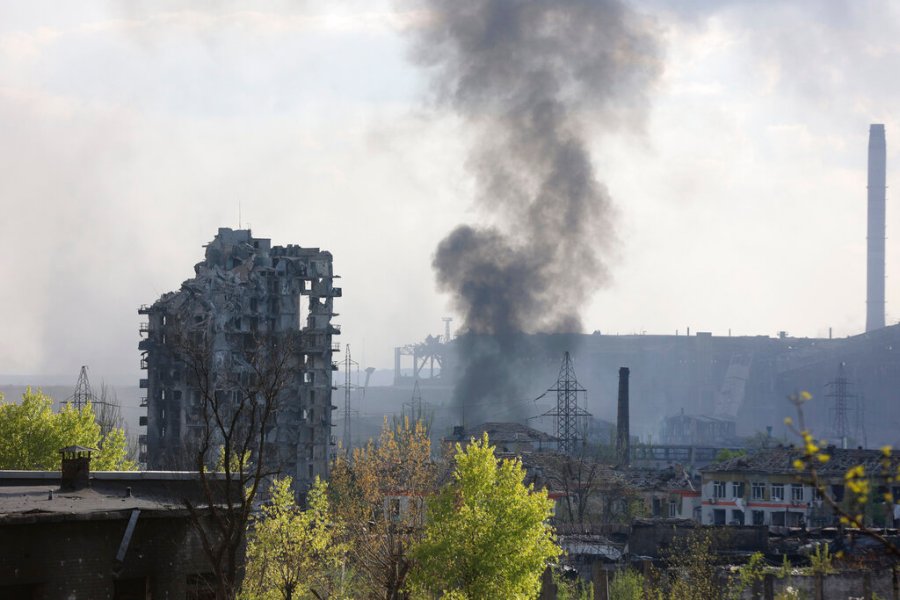Fear, grief: What evacuees of Mariupol steel mill went through

In this handout photo taken from video released on Wednesday, May 4, 2022 by Donetsk People’s Republic Interior Ministry Press Service, Smoke rises from the Metallurgical Combine Azovstal in Mariupol, in territory under the government of the Donetsk People’s Republic, eastern Ukraine. (Donetsk People’s Republic Interior Ministry Press Service via AP)
ZAPORIZHZHIA, Ukraine (AP) — When the moist concrete walls deep below ground and the mold and the cold and the weeks without fresh fruit or vegetables became too much to bear, some in the bunker underneath Elina Tsybulchenko’s office decided to visit the sky.
They made their way, through darkness lit by flashlights and lamps powered by car batteries, to a treasured spot in the bombarded Azovstal steel plant, the last Ukrainian holdout in the ruined city of Mariupol. There, they could look up and see a sliver of blue or smoky gray. It was like peering from the bottom of a well. For those who could not, or dared not, climb to the surface, it was as distant as peace.
But seeing the sky meant hope. It was enough to make Elina’s adult daughter, Tetyana, cry.
The Tsybulchenko family was among the first to emerge from the steel plant in a tense, days-long evacuation negotiated by the United Nations and the International Committee of the Red Cross with the governments of Russia, which now controls Mariupol, and Ukraine, which wants the city back. A brief cease-fire allowed more than 100 civilians to flee the plant.
They arrived safely in the southern Ukrainian city of Zaporizhzhia this week. There, they described for The Associated Press their two months at the center of hell, and their escape.
Hundreds of civilians and Ukrainian fighters remain trapped at the plant and Russian forces have pushed their way inside. The seizure of Mariupol is expected to play a central role in Moscow’s celebration on May 9 of Victory Day, historically marking the end of World War II.
In the earliest days of Russia’s invasion Tsybulchenko, 54, was shocked by the bombardment of her city. Like many residents with memories of civil defense drills, she knew the steel plant had the only real bunkers in town. When she, her husband Serhii, her daughter and her son-in-law Ihor Trotsak decided to hole up in the one under her office, she assumed they would stay a few days.
“We didn’t even take toothbrushes,” Elina said. But a few days turned into 60.
They had brought only their documents, three blankets, two dogs and fruit carried in a basket they used for Orthodox Easter. They didn’t think they would mark the holiday there weeks later.
The steel plant has a maze of more than 30 bunkers and tunnels spread out over its 11 square kilometers (4 miles), and each bunker was its own world. Evacuees had little or no communication with those elsewhere in the plant; they would eventually meet on the buses to Zaporizhzhia and compare experiences.

Their isolation complicates estimates of the number of civilians and Ukrainian fighters who remain. A few hundred civilians are still trapped, the Ukrainian side said this week, including more than 20 children. Another evacuation effort was reported underway Friday.
The number of those surviving underground threatens to drop every day. Some evacuees recalled watching in horror as the wounded succumbed to their injuries while first aid supplies, even clean water, ran short or ran out.
“People literally rot like our jackets did,” said 31-year-old Serhii Kuzmenko. The weary foreman at the plant fled along with his wife, 8-year-old daughter and four others from their bunker; 30 were left behind. “They need our help badly,” he said. “We need to get them out.”
In another bunker, the Tsybulchenko family lived among 56 people, including 14 children ages 4 to 17. They survived by dividing among themselves the bare rations that fighters brought down —tinned meat, porridge, crackers, salt, sugar, water. There was not enough to go around.
The family’s old cocker spaniel suffered, shivering and staring at them with wide eyes. The dog had to die, they decided. It was an act of mercy. They asked a soldier for sleeping pills, but he said the dog might survive and suffer more.
“Let me shoot it,” he said.
The dog was given a hurried burial above ground amid the shelling; rubble and scrap metal were placed atop it, to protect it from other, starving pets.
There was little comfort. The bunker shook from bombardment. “We went to bed like this every night and thought, ‘Will we survive?’” Elina said.
The Tsybulchenkos and others slept on benches padded with the uniforms of steel plant workers. For toilets, they used buckets. When the bombardment became too heavy to empty the buckets upstairs, they used plastic bags. To pass the time, people made up board games or played cards. One carved bits of wood into toys.
A room in the bunker became a playground for the children. People found markers and paper and held an arts and crafts contest, with the children drawing what they would like to see the most. They drew nature and the sun. As Easter approached in late April, they drew Easter eggs and bunnies.
The drawings were posted on walls that dripped with moisture. Dank-smelling mold crept from the corners and migrated to clothing and blankets. The only way to keep something dry was to wear it. Even after evacuation and after their first proper showers in months, the Tsybulchenkos worried they smelled of mold.
While they tried to collect rainwater, they often used sanitizer to clean themselves and their dishes, to the point where Elina’s hands showed an allergic reaction. In the early days, she went up to her office and brought down lotion, deodorant and a few other personal items she had left there.
Then it became too dangerous to go above. Half the building, including her office, collapsed in the bombardment.
Again and again over the two months, people in the bunker would hear word of possible evacuations from Mariupol, only to learn they had failed. When news arrived of the U.N.-negotiated evacuation, there was skepticism and fear. But the planning began with decisions on who should leave first.
Others said the Tsybulchenkos should go because Elina’s cramped legs had started to blacken and give her trouble. “But there are small children here, and they should go,” she said. The others insisted. They assumed the evacuation would continue in the days ahead and take everyone, even the fighters. Some hesitated, wanting to see whether the first evacuation was a success.
A small girl staying behind, Violeta, took a marker and drew a flower, a heart and “Good luck” on Elina’s arm. The bunker residents had shortened the girl’s name to Leta, or “sunlight.”
Everyone in the bunker agreed to meet to celebrate at a cafe in Zaporizhzhia when the evacuation was complete.
“We’re so sorry,” the Tsybulchenkos told the others as they started toward the surface.
“Don’t worry,” they replied. “We’ll follow.”
___
Elina didn’t recognize her workshop. The roof had been blown away. Walls were in ruins. The ground was pocked with craters and strewn with unexploded shells.

As they emerged from an opening in the rubble, the family and other evacuees blinked. After two months, the sunlight hurt their eyes.
It was quiet. The Russian bombardment, for once, had stopped.
“The weather was brilliant,” said Ivane Bochorishvili, the U.N. deputy humanitarian chief in Ukraine, who approached the plant to await the evacuees. “The one when you are waiting for the perfect storm, like the blue sky.”
A dangerous stretch lay ahead. A railway bridge near the plant was the receiving point for evacuees. The waiting buses were another kilometer away.
For the evacuation, the Russians had tried to retrieve the mines they had planted. But the machine hadn’t detected everything, Bochorishvili said.
As he and a colleague approached in their vehicle, the Russians shouted from hundreds of meters away — “Don’t move!” The U.N. workers were told to get out and go back carefully to the last checkpoint on foot. The de-mining machine was brought in again. Eight more mines were found.
Ukrainian soldiers walked ahead and behind the evacuees as they finally emerged, making sure the column of people placed their feet safely.
“Thank God we didn’t see any bodies along the way,” Elina said. The Russians had removed them.
Twenty-one people emerged the first day. The rest came out the next. As the second group met the first, “there were all these hugs and kisses. They’d been in Azovstal but hadn’t seen each other, didn’t know what happened to each other,” said Osnat Lubrani, U.N. humanitarian coordinator in Ukraine.
The buses set off through a ruined city. Makeshift graves lined the streets. People held their heads in grief and disbelief or hugged each other. “These people are going to have longtime nightmares,” said Esteban Sacco, the U.N. official responsible for the first leg of the bus journey to safety.
And yet they could still see signs of life. It was market day. There were people walking or biking, even children. Some peered through windows of bombed-out buildings.
The evacuees were still far from safe. The buses at first headed not west toward Ukrainian-held territory but east toward Russia. Even the U.N. staffers at first thought they were going there, Sacco said.
In a camp at Bezimenne, near the border, the evacuees said they faced pressure from the Russians to go to their side. The Russians even tried to board the buses, saying they wanted to offer the children candy, but they were kept out.
A Russian priest asked evacuees why they were going to Zaporizhzhia. “Ukraine will cease to exist very soon,” Elina Tsybulchenko recalled him saying.
The evacuees were questioned and searched, even stripped at times to check for military-style tattoos. Some Russians were polite, said Ihor, Elina’s son-in-law. Others were mocking or insulting, especially if he slipped and spoke Ukrainian instead of Russian. “Why are you speaking a foreign language?” they asked.
The buses turned west for the slow route toward Zaporizhzhia and safety. “We always had this fear,” Ihor said. “We knew we could’ve ended up going to Russia.”
As the convoy slowly arced around Mariupol, they could see faraway flashes as the Russian bombardment resumed. Two civilian women at the steel plant were killed and 10 civilians wounded, said Sviatoslav Palamar, deputy commander of Ukraine’s Azov Regiment there.
Ukrainian authorities said Russian forces pushed into the plant’s perimeter with “heavy, bloody battles.”
The evacuees had entered their bunkers in winter. They emerged to a black-and-gray landscape, a grotesque spring. Only after passing through no man’s land did Elina notice green and yellow fields again.
They entered Ukrainian-held territory after a harrowing, final stretch of more than 20 checkpoints.
Ukrainian officials had urged residents of Russian-controlled communities to climb aboard the convoy along the way. But in the end, the buses were not allowed to take them. Elina and other evacuees cried as they passed people standing near the road, waiting in vain.
“We really felt shame,” Elina said. “We never stopped.”
___
Yesica Fisch in Zaporizhzhia, Ukraine, contributed.














